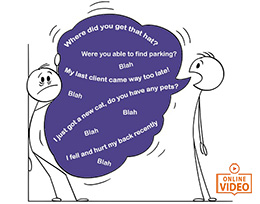 Want to earn continuing education credit for this article? Learn more.
Want to earn continuing education credit for this article? Learn more.
A majority of massage therapy’s patrons are eager for the relaxation and/or therapeutic benefits of bodywork. Despite this general trend, massage therapy still subscribes to the service industry and, as such, its professionals interface with the unpredictable public. While the possibilities of encountering a challenging customer often depends on the type of practice you work in, few massage therapists completely escape an occasional encounter with a difficult client.
Although it may be uncomfortable to recount tales of challenging clients, bodyworkers can take solace in knowing that their colleagues also deal with abrasive personalities. Some qualities that can land people in this category include those who:
- are disrespectful to the practitioner
- freely express prejudices
- talk unfavorably about others
- use inappropriate language or references
The first step in keeping your cool when a client proves to be a challenge, is to own your contribution to the problem. As outlined by the universally understood Law of Attraction, like begets like. When viewed within the framework of a difficult client, this translates to a therapist’s own negativity has the potential to bring people into their practice with energy to match.
Self-Neglect
For caregivers, neglecting their own needs is one of the prime culprits for such negative energy. According to Nina McIntosh, author of The Educated Heart, there are several warning signs your self-care needs more attention:
- The therapist begins to dread his or her clients’ arrivals.
- The therapist’s physical symptoms worsen while working.
- The therapist is irritable or rude with clients.
- Time moves very slowly during a session.
- The majority of a therapist’s clients seem to be difficult or demanding.
- A therapist’s clients ask, “How many sessions have you done today?” or “Do you ever get bodywork for yourself?”
- A therapist easily gets distracted while giving a massage.
- A therapist lacks inspiration about bodywork, health and healing.
In the August/September 2005 edition of Massage & Bodywork, McIntosh advises therapists take time off to rejuvenate and care for themselves if the above eight statements ring true a majority of the time.
Countertransference
In addition to neglecting your own self-care, countertransference may be at the root of an uncomfortable interaction with a client. According to the NCBTMB’s handbook, countertransference is defined as “a practitioner’s unresolved feelings and issues, which are unconsciously transferred to the client.”
When a client seems challenging, it is important to assess whether you are transferring feelings about a different person or situation to your current interaction. All too often, the client’s words, attitude or behavior function as a trigger for the therapist’s unresolved issues. For this very reason, bodyworkers must be able to analyze and identify the underlying reason for their perception of a difficult client. Recognizing that you are transferring feelings about someone else to your client is usually sufficient to change your perspective. For more information about this phenomenon and how to prevent it, read “How Countertransference Jeopardizes the Therapeutic Relationship.”
Practical Steps
Whether a therapist believes that he or she has or has not contributed to attracting or perceiving a challenging personality into his or her practice, there are several steps to make the session more pleasant. Depending on the situation, the following suggestions may or may not be appropriate:
- Seek Positive Traits – Look for a great quality in your client and focus on that.
- De-stress – Release any stress you may be holding before seeing clients to clear away your negative energy.
- Create Boundaries – If your client pushes limits or is disrespectful, assertively define appropriate behavior within your practice.
- Refer Out – If the stress associated with a specific client cannot be overcome, remember your prerogative to refer elsewhere.
While these tactics work for the majority of challenging clients, they are not foolproof. Practitioners must let their safety, better judgment and professional ethics guide them whenever questionable circumstances arise.
Different personalities abound and, as more people seek bodywork, their diversity is represented in massage therapists’ clientele. Since so many now choose to receive bodywork, a client who rubs you the wrong way is likely to surface eventually. When this happens, therapists must first evaluate the possibility that they are contributing to the problem. Such recognition swiftly diffuses the situation. Additionally, seeking your client’s positive traits, releasing your stress, adhering to professional boundaries and referring troublesome clients to a different practitioner are all ways to help massage therapists manage their difficult patrons.
Earn continuing education credit for this article contained in our Health Maintenance – Mind & Body series. Click here to enroll.














